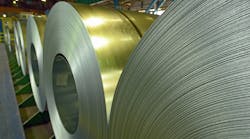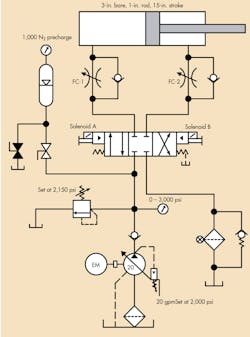A coil steel processing plant recently had a machine that ran 24/7 when the plant was operational; it lost all hydraulic pressure. Plant personnel had emailed me a copy of the original hydraulic schematic (shown) they were given when the unit was installed, hoping I could help them solve the problem over the phone.
They kept telling me a directional valve was mounted on top of the relief valve. One of the mechanics thought it was added during commissioning and debugging to fix a problem with the electric motor not having enough power to get the system up and running. The solution at the time was to add a single solenoid directional control valve to the top of the relief. They also felt the system ran hot from day one.
The circuit symbol indicated a directly operated relief valve, but it probably was a pilot-operated unit, which would allow changing the head to a solenoid-operated relief/unloading valve. This would let the electric motor build speed with no load. Energizing the added-on solenoid would provide a safety relief setting.
Some time after the system was operational, a more powerful electric motor was added. The unloading feature was not used so the directional valve was left energized, rendering the valve as a safety relief any time the system was running.
I told technicians to check the control orifice in the main stage of the relief valve and to make sure the directional valve on top was working properly. To do this, my instructions were to check the pilot poppet and spring. They assured me all was okay, but they still had no pressure and planned to replace the pump, which had a 10-week delivery promise.
I visited the job site and had trouble believing it was the pump. Everyone had an opinion about the pump, cylinder, directional control valve, and even the accumulator. What do you think was the problem?
Find the Solution
Think you know the answer to this month’s problem? Submit your solution by emailing [email protected]. All correct solutions submitted by Aug. 3, 2017, will be entered into a random drawing for a $50 gift card. The winner will be notified, and his or her name will be printed in a future issue. Only one gift card will be awarded to any participant within a calendar year.
Congratulations to Sean Carroll, Technical Services Manager at Ralph W. Earl Co. A $50 gift card is in the mail to him.
Solution to Last Month’s Challenge: Regenerative Circuit Fails to Close
The shuttle valve failure (where the ball was lodged deeply into one end) is a result of high speed shifting with maximum pressure available. Even though control orifices regulate the opening and closing speed of the main logic poppet, there were no orifices controlling the speed of the floating ball. This caused the ball to hammer as it shifts back and forth. The addition of two orifices in the pilot lines that feed the shuttle valve solved the problem. Holes were drilled and tapped through the slip-in cartridge cover, so it was a simple matter of installing 0.015-in. orifice plugs into the tapped holes.


